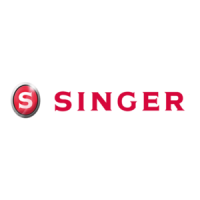
Do you have a question about the Singer 50T8 E99670 and is the answer not in the manual?
| Presser Foot Pressure | Adjustable |
|---|---|
| Maximum Sewing Speed | 750 stitches per minute |
| Type | Electronic |
| Buttonhole Styles | 6 |
| Included Feet | All-Purpose Foot, Zipper Foot, Buttonhole Foot, Satin Stitch Foot, Blind Hem Foot, Overcasting Foot, Button Sewing Foot |
| Bobbin | Drop-in |
Instructions to reduce the risk of electric shock when using the appliance.
Warnings to prevent burns, fire, electric shock, or injury during use.
Instruction to keep the safety instructions for future reference.
Dial for adjusting upper thread tension.
Adjusts pressure of presser foot on fabric.
Lever that lifts and lowers thread during sewing.
Device for cutting thread after sewing.
Holds fabric against the feed dogs.
Plate with hole for needle passage.
Extends work surface or stores accessories.
Lever to sew backwards.
Stops bobbin winding.
Adjusts the length of stitches.
Displays selected stitch pattern.
Lowers feed dogs for free motion sewing.
Lever for operating the buttonhole mechanism.
Device to help thread the needle.
Holds the spool of thread.
Mechanism for winding thread onto the bobbin.
Manual control for raising/lowering needle.
Selects different stitch patterns.
Turns machine on/off and controls light.
Where the power cord connects.
Guides bobbin thread during winding.
Guides upper thread through tension unit.
Cover for the front of the machine.
For carrying the machine.
Lever to raise/lower presser foot.
Adjusts balance of buttonhole stitches.
Controls sewing speed via foot pedal.
Connects machine to power source.
Includes common accessories like feet, needles, and tools.
Lists additional accessories available for purchase.
Safety reminder to unplug the machine when not in use.
Explains the function of the foot control pedal.
How to turn on the machine's sewing light.
Crucial safety information regarding polarized plugs.
How to raise the presser foot to a higher position.
How to adjust pressure for different fabric types.
Steps to attach the presser foot holder.
How to attach various presser feet.
Steps to detach the presser foot.
How to attach the seam guide accessory.
Important note about the bobbin winder spindle position.
Safety reminder to turn off power before inserting bobbin.
Safety reminder to turn off power before changing needles.
Importance of using good quality, undamaged needles.
Refers to instructions for automatic needle threader on another page.
Safety reminder to turn off power before using threader.
Adjusting tension for the top thread.
Testing and adjusting bobbin thread tension.
Notes on achieving proper tension balance.
How to sew stitches in reverse to secure seams.
Steps to remove fabric from the machine.
How to use the built-in thread cutter.
Table matching needle size, fabric type, and thread.
Details on specific SINGER needle types.
Notes on using twin needles.
How to select and adjust for straight stitch.
How to select and adjust for zigzag stitch.
How to perform straight stitching and stitch length settings.
How to perform zigzag stitching and adjust width/density.
Explains stitch length dial effect on zigzag stitches.
Emphasizes the need for practice for blind hems.
Using standard overlock stitch for knits and edges.
Using double overlock stitch for knits and seams.
Recommendation for needle types for overcasting.
Standard process for creating buttonholes.
Specifics for sewing buttonholes on stretchy materials.
Using multi-stitch zig-zag for lace, elastic, darning, etc.
Using bar tack for reinforcing pleats and pocket openings.
Explains how fabric movement is operator-controlled.
For decorative edges on sheer or stretch fabrics.
For delicate edge finishes.
For gathering with cord or elastic.
Cross-reference for reverse sewing instructions.
Note about optional gathering foot and alternatives.
Safety precaution for all cleaning operations.
Steps to remove the needle plate for cleaning.
How to clean the feed dog area.
Instructions for cleaning and lubricating the hook mechanism.
Importance of regular cleaning.
Causes and solutions for upper thread breakage.
Causes and solutions for lower thread breakage.
Causes and solutions for skipped stitches.
Causes and solutions for needle breakage.
Causes and solutions for loose stitches.
Causes and solutions for fabric gathering or puckering.
Causes and solutions for uneven stitching or feed.
Causes and solutions for a noisy machine.
Causes and solutions for the machine jamming.